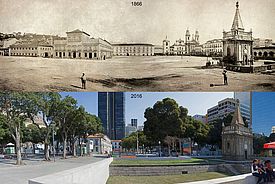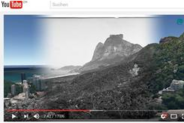19.10.2016 | News
Researchers of the Swiss Federal Institute WSL in Cadenazzo have developed a software tool which uses historical photographs to trace the development of a landscape over time. This solution has attracted the interest of a cultural institute in Brazil which invited the program's developers to Rio de Janeiro.
As director of the photography department at the Instituto Moreira Salles (IMS), Sérgio Burgi is responsible for managing thousands of photographs of Rio taken from 1860 on, taking him on a journey through the centuries. Over the years, professionals from all over the world – including Swiss photographer Georges Leuzinger (1813-1892) – captured on glass plates the breathtaking views of this city situated in the shadow of Sugarloaf Mountain. These images make all too clear the amazing extent to which humans have transformed town and country landscapes alike, not only by construction but also by excavating entire hills and fillingin coastal bays, thus claiming areas of land from the oceans.
How to best use thousands of historical photographs?
One of Burgi's main preoccupations as he strives to draw the most out of his photographic archive is to use the items featuring in the photos to locate the exact spot where the pictures were taken and identify the areas shown there. While searching the internet on the lookout for a way to do this, he found out about the WSL Monoplotting Tool. This program was developed by mathematician Claudio Bozzini in collaboration with Patrik Krebs and Marco Conedera, all of them researchers on the Cadenazzo site of the WSL. Monoplotting is a scientifically well documented technique which despite having been around since the 1970s, had previously been without a practical implementation interface. Now, though, the WSL software allows historical subjects – for example former stables that no longer exist – to be accurately pinpointed geographically. All you need is a decent digital terrain model along with the ability to distinguish at least five locations in the photo whose exact position you are also familiar with on the ground. Burgi was won over completely by the product when he discovered that, as well as meeting all his functional needs, this was a user-friendly software package that worked on standard PCs. From his many years of experience managing and researching photographic archives, it was clear to him that the WSL Monoplotting Tool (or the "ferramenta de monoplotagem do WSL" as it is known in Portuguese) was just what he had been trying to find for so long.
WSL software, presented at House of Switzerland
Burgi visited the WSL researchers during a trip to Europe in late March 2016.Together they devised a strategy for introducing the Monoplotting Tool for use at the IMS and rolling it out to its partners – in particular to Prof. Farès el-Dahdah's group at Rice University in Houston, Texas, working on the imagineRio project (imaginerio.org). On his return to Brazil, Burgi managed to also warm the Swiss consulate to the idea. Bozzini and Conedera were then invited to spend a week in Rio in early September 2016 to present the project in the state-of-the-art setting of the House of Switzerland that had made its appearance in the city for the Olympics and Paralympics. In addition to their official or public events, the two researchers led a course providing an introduction to using monoplotting and participated in a seminar on photography and urban dynamics at the IMS headquarters, followed by a presentation at the Brazilian Army Geographic Service. These visits have established an invaluable network of contacts bringing together the experts at the IMS, the Pontifical Catholic University of Rio de Janeiro (PUC-Rio), and Rice University in Houston (USA) which can now be harnessed for future collaboration and projects focusing on georeferencing historical photographs.
Burgi now has the task of selecting the relevant photos and creating a historical resource – one that is sure to capture the imagination of the public if Ticino's response to WSL's "Bellinzona and its castles: a century of changes" movie footage is anything to go by.ar.
Copyright ¶
Copyright ¶
WSL and SLF provide the artwork for imaging of press articles relating to this media release for free. Transferring and saving the images in image databases and saving of images by third parties is not allowed.





